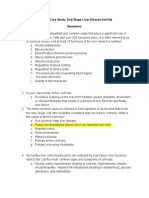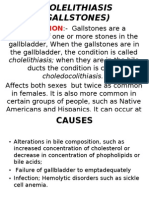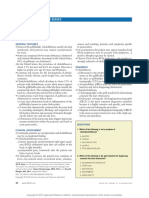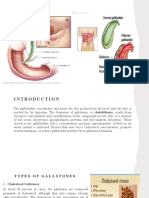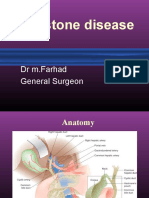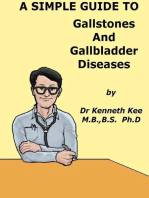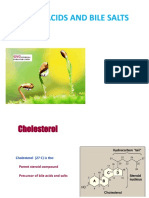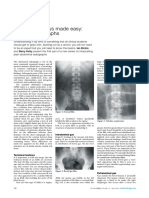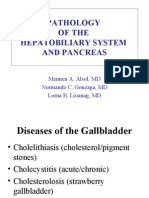Cholelithiasis
Uploaded by
Jala JoshnaCholelithiasis
Uploaded by
Jala JoshnaDIETETICS
CHOLELITHIASIS
Introduction
Cholelithiasis refers to the formation of gallstones (choleliths) in the gallbladder due to an
imbalance in the composition of bile. Gallstones are solid deposits made up of cholesterol,
bilirubin, calcium salts, and other substances
found in bile. These stones can vary in size
and number and may be asymptomatic or
lead to complications such as biliary colic,
cholecystitis, cholangitis, or pancreatitis if
they obstruct bile flow.
Types of Gallstones (Cholelithiasis)
Gallstones (choleliths) are classified based on their composition, which determines their
formation, risk factors, and clinical implications. The three primary types are:
1. Cholesterol Stones (80%)
These are the most common type of gallstones and are composed primarily of cholesterol (50-
100%) with small amounts of calcium salts, bile pigments, and proteins.
Formation:
Bile normally contains bile salts and phospholipids that keep cholesterol dissolved.
When there is excess cholesterol or low bile salt concentration, cholesterol crystallizes
and forms stones.
These stones grow slowly over time in the gallbladder.
Risk Factors:
Obesity & Metabolic Syndrome – Increased cholesterol secretion in bile.
Dietary Factors – High fat, high cholesterol, low fiber intake.
Rapid Weight Loss – Mobilization of cholesterol from fat stores increases bile
cholesterol saturation.
Female Gender & Pregnancy – Estrogen increases cholesterol secretion and decreases
gallbladder motility.
Aging (>40 years old) – Decreased bile acid production.
Diabetes Mellitus & Insulin Resistance – Associated with altered bile composition.
Medications – Oral contraceptives, hormone replacement therapy, statins, and fibrates.
Characteristics:
Yellow-green in color due to cholesterol.
Can be solitary or multiple, varying in size.
Often asymptomatic but may cause biliary colic when obstructing the cystic duct.
2. Pigment Stones (15-20%)
Jala Joshna
DIETETICS
Pigment stones are composed primarily of calcium bilirubinate along with other bile pigments,
calcium, and proteins.
Types of Pigment Stones:
A. Black Pigment Stones
Hard and brittle.
Formed due to excess unconjugated bilirubin.
Typically found in the gallbladder.
Associated with chronic hemolysis (destruction of red blood cells).
B. Brown Pigment Stones
Softer and greasy in texture.
Contain calcium bilirubinate, cholesterol, and fatty acids.
Typically found in the bile ducts rather than the gallbladder.
Formed due to biliary infections and bile stasis.
Risk Factors for Pigment Stones:
Chronic Hemolytic Disorders: Sickle cell disease, hereditary spherocytosis, thalassemia
(black stones).
Liver Cirrhosis: Reduced conjugation of bilirubin (black stones).
Biliary Tract Infections: Bacterial or parasitic infections (e.g., Clonorchis sinensis,
Ascaris lumbricoides) promote brown stone formation.
Total Parenteral Nutrition (TPN): Reduced gallbladder contraction leads to bile stasis
(brown stones).
Characteristics:
Black stones: Small, multiple, and fragile.
Brown stones: Softer, greasy, and larger.
3. Mixed Stones
Composed of cholesterol, bile pigments, calcium, and other components.
Considered a combination of cholesterol and pigment stones.
More common in patients with chronic gallbladder disease.
Risk factors are a combination of those for cholesterol and pigment stones.
Characteristics:
Vary in color and consistency.
Found in both gallbladder and bile ducts.
Often associated with chronic inflammation of the gallbladder (cholecystitis).
Causes and Risk Factors:
Dietary Factors: High cholesterol, low fiber, high refined carbohydrates.
Obesity and Metabolic Syndrome: Increases cholesterol secretion in bile.
Jala Joshna
DIETETICS
Rapid Weight Loss: Causes bile supersaturation with cholesterol.
Hormonal Factors: Pregnancy, oral contraceptives, and hormone replacement therapy
increase bile cholesterol.
Genetics: Family history of gallstones.
Liver and Biliary Tract Diseases: Cirrhosis, biliary infections.
Diabetes and Insulin Resistance: Associated with altered bile composition.
Medications: Certain drugs like ceftriaxone and octreotide.
Symptoms
Cholelithiasis can be asymptomatic or present with various gastrointestinal and systemic
symptoms, depending on whether the stones cause obstruction or inflammation.
1. Asymptomatic Cholelithiasis
About 70-80% of individuals with gallstones remain asymptomatic.
Gallstones are often incidentally detected during imaging for other conditions.
2. Symptomatic Cholelithiasis
When gallstones obstruct the cystic duct or common bile duct, symptoms may develop,
including:
A. Biliary Colic
Definition: Sudden, intense, cramping or dull pain in the right upper quadrant (RUQ) or
epigastrium.
Radiation: Pain may radiate to the right shoulder or back.
Triggers: Often occurs after a fatty meal due to gallbladder contraction.
Duration: Lasts 30 minutes to a few hours, then subsides gradually.
B. Nausea and Vomiting
Often associated with biliary colic.
May worsen after fatty or heavy meals.
C. Dyspepsia and Indigestion
Bloating, gas, and belching (flatulence).
Feeling of fullness or discomfort in the upper abdomen.
D. Jaundice (Obstructive)
Yellowish discoloration of the skin and sclera (eyes).
Caused by blockage of the common bile duct, leading to buildup of bilirubin.
Often associated with dark urine and pale (clay-colored) stools.
E. Acute Cholecystitis (Inflamed Gallbladder)
If a stone blocks the cystic duct, it can lead to infection and inflammation. Symptoms include:
Severe, persistent RUQ pain lasting >6 hours.
Fever (>38°C/100.4°F), chills (indicating infection).
Jala Joshna
DIETETICS
Murphy’s sign: Pain and inspiratory arrest when pressing the RUQ.
F. Cholangitis (Life-Threatening Infection of the Bile Ducts)
Occurs when gallstones cause a bacterial infection in the biliary system. Classic Charcot’s Triad
includes:
1. RUQ pain
2. Fever with chills
3. Jaundice
In severe cases, Reynolds' Pentad (Shock + Confusion) may develop.
G. Pancreatitis (Gallstone-Induced Inflammation of the Pancreas)
When a gallstone blocks the pancreatic duct, it can trigger acute pancreatitis, leading to:
Severe epigastric pain radiating to the back.
Nausea and vomiting.
Elevated serum amylase and lipase levels.
Symptom Description
Biliary Colic Sudden, intense RUQ/epigastric pain, triggered by fatty meals, lasts <6
hrs
Nausea & Vomiting Common with biliary colic, worsens with fatty meals
Dyspepsia Bloating, indigestion, belching, fullness
Jaundice Yellow skin/eyes, dark urine, pale stools (bile duct obstruction)
Acute Cholecystitis Persistent RUQ pain (>6 hrs), fever, Murphy’s sign
Cholangitis RUQ pain, fever, jaundice (Charcot’s Triad), shock/confusion in severe
cases
Pancreatitis Epigastric pain radiating to back, nausea, elevated amylase/lipase
Diagnosis of Cholelithiasis (Gallstones)
The diagnosis of cholelithiasis involves a combination of clinical assessment, imaging studies,
and laboratory tests to detect gallstones and associated complications.
1. Clinical Assessment
A thorough history and physical examination are essential for diagnosing gallstones.
History:
Recurrent right upper quadrant (RUQ) or epigastric pain (biliary colic).
Pain triggered by fatty meals.
Associated symptoms: nausea, vomiting, bloating, jaundice (if obstruction).
Physical Examination:
Murphy’s Sign: Tenderness in the RUQ during deep inspiration (suggests cholecystitis).
Boas’ Sign: Hyperesthesia (increased sensitivity) below the right scapula.
2. Imaging Studies
A. Abdominal Ultrasound (USG) – First-Line Test
Jala Joshna
DIETETICS
Most sensitive and specific test for gallstones in the gallbladder (Sensitivity: 95%, Specificity:
90%).
Findings:
Hyperechoic (bright) gallstones with posterior acoustic shadowing.
Sludge (thickened bile) in the gallbladder.
Gallbladder wall thickening (>3 mm) and pericholecystic fluid (suggests cholecystitis).
B. CT Scan (Computed Tomography) of the Abdomen
Less sensitive than ultrasound for gallstones but useful for detecting complications
(perforation, abscess, pancreatitis).
Used when ultrasound results are inconclusive.
C. Magnetic Resonance Cholangiopancreatography (MRCP)
Best non-invasive test for detecting common bile duct (CBD) stones.
Used when bile duct obstruction or cholangitis is suspected.
Can visualize gallbladder, bile ducts, and pancreatic ducts.
D. Endoscopic Ultrasound (EUS)
High sensitivity for detecting small gallstones or microlithiasis (<3 mm).
Used when bile duct stones are suspected but not visible on USG or MRCP.
E. Endoscopic Retrograde Cholangiopancreatography (ERCP) – Diagnostic & Therapeutic
Gold standard for detecting and removing bile duct stones.
Procedure: A flexible endoscope with fluoroscopy is used to inject contrast into the bile
duct.
Indications:
Confirmed CBD stones (choledocholithiasis).
Suspected obstructive jaundice or cholangitis.
Complications: Risk of pancreatitis, infection, perforation.
3. Laboratory Tests
A. Liver Function Tests (LFTs) – To Assess Biliary Obstruction
Alkaline Phosphatase (ALP) & Gamma-Glutamyl Transferase (GGT): Elevated in bile duct
obstruction.
Bilirubin (Total & Direct): Increased in CBD obstruction.
Alanine Aminotransferase (ALT) & Aspartate Aminotransferase (AST): Elevated in
hepatocellular involvement.
B. Complete Blood Count (CBC) – To Detect Infection
Leukocytosis (High WBC count): Suggests cholecystitis or cholangitis.
C. Serum Amylase & Lipase – To Rule Out Gallstone Pancreatitis
Elevated lipase & amylase indicate pancreatitis due to gallstones blocking the pancreatic duct.
Jala Joshna
DIETETICS
Dietary Management of Cholelithiasis (Gallstones)
A well-planned diet plays a crucial role in managing cholelithiasis, reducing symptoms, and
preventing complications. The primary goals of dietary management are to:
Reduce gallbladder workload by limiting high-fat foods.
Promote bile flow and prevent stone formation.
Maintain a healthy weight and prevent obesity-related gallstone risks.
✅
1. General Dietary Guidelines
Foods to Include (Gallbladder-Friendly Diet)
Low-fat foods: Helps prevent gallbladder stimulation.
High-fiber diet: Reduces cholesterol absorption and supports bile flow.
Lean proteins: Skinless chicken, fish, tofu, and legumes are preferred.
Complex carbohydrates: Whole grains, oats, brown rice, and quinoa.
Healthy fats: Small amounts of olive oil, flaxseeds, and nuts help prevent bile stagnation.
Plenty of fluids: At least 2.5-3 liters of water daily to aid digestion.
🚫 Foods to Avoid (Trigger Gallbladder Pain & Stone Formation)
High-fat and fried foods: Butter, cheese, full-fat dairy, fried snacks.
Processed foods: Packaged chips, bakery items, and fast food.
Red meat and organ meats: High in saturated fats and cholesterol.
Sugary and refined foods: White bread, sodas, sweets, and pastries.
Carbonated beverages & alcohol: Can trigger bloating and bile stasis.
2. Nutritional Composition for Cholelithiasis Diet
Nutrient Recommended Intake Rationale Sources
Calories Adjusted to BMI (1200- Maintain healthy Balanced diet
1800 kcal) weight
Fat < 25-30% of total calories Prevent gallbladder Olive oil, flaxseeds
over stimulation
Protein 0.8-1.0 g/kg body weight Maintain muscle mass Egg whites, fish, tofu
Carbohydrates 50-60% of total calories Prevent bile stagnation Whole grains, fruits
Fibre 25-30 g/day Reduce cholesterol Vegetables, beans,
absorption flaxseeds
Fluids 2.5-3 L/day Prevent bile thickening Water, herbal teas
3. Additional Dietary Recommendations
A. Weight Management
Overweight individuals should aim for slow weight loss (0.5-1 kg/week).
Crash diets or fasting should be avoided as they increase the risk of gallstone formation.
Jala Joshna
DIETETICS
B. Gallstone Prevention Through Diet
Increase plant-based foods (fiber-rich) to lower cholesterol.
Avoid skipping meals to prevent bile concentration.
Incorporate moderate exercise to support digestion.
Dietary requirements
Before Surgery (Pre-Cholecystectomy):
Low-Fat Diet: Reduces gallbladder contractions and symptoms.
High-Fiber Foods: Fruits, vegetables, whole grains to improve digestion.
Adequate Hydration: Supports bile flow.
Lean Proteins: Fish, chicken, tofu, and legumes instead of fatty meats.
Avoid:
Fried and fatty foods (butter, cheese, processed foods).
High-cholesterol foods (red meat, egg yolks).
Sugary foods and refined carbohydrates.
Alcohol and caffeine (may trigger gallbladder attacks).
After Surgery (Post-Cholecystectomy):
Smaller, Frequent Meals: To aid digestion in the absence of the gallbladder.
Gradual Reintroduction of Fats: Start with healthy fats (olive oil, nuts).
Probiotic-Rich Foods: Yogurt, kefir, and fermented foods support gut health.
Avoid Gas-Producing Foods: Beans, cabbage, and carbonated drinks.
Key Takeaways
✔ Follow a low-fat, high-fiber diet with lean proteins.
✔ Stay hydrated to maintain bile consistency.
✔ Eat small, frequent meals to prevent gallbladder stress.
✔ Avoid fried, processed, and high-cholesterol foods.
✔ Maintain a healthy weight with gradual weight loss.
References
Clinical Nutrition for Gastrointestinal Disorders, 2nd Edition, Chapter on Cholelithiasis
Harrison’s Principles of Internal Medicine, 21st Edition, Chapter on Gallstone Disease
Management
Guyton & Hall’s Textbook of Medical Physiology, Chapter on Digestive System Disorders.
Mahan’s Krause’s Food & Nutrition Therapy, 14th Edition, Chapter on Hepatobiliary
Disorders.
Jala Joshna
You might also like
- Pathophysiology: Cholecystitis Non Modifiable Factors Modifiable Factors100% (2)Pathophysiology: Cholecystitis Non Modifiable Factors Modifiable Factors4 pages
- Cholelithiasis and Choledocholithiasis Infos ..No ratings yetCholelithiasis and Choledocholithiasis Infos ..5 pages
- Extrahepatic Biliary Tract Pathology - Cholidolithiasis, Cholidocholithiasis, Cholecystitis and CholangitisNo ratings yetExtrahepatic Biliary Tract Pathology - Cholidolithiasis, Cholidocholithiasis, Cholecystitis and Cholangitis60 pages
- Med Surg 2 - 10 Nursing Care of Clients With Biliary DisordersNo ratings yetMed Surg 2 - 10 Nursing Care of Clients With Biliary Disorders4 pages
- Gallstone Disease [Medicalstudyzone.com]No ratings yetGallstone Disease [Medicalstudyzone.com]29 pages
- Metabolic Disorders Billiary Disorder HandoutsNo ratings yetMetabolic Disorders Billiary Disorder Handouts12 pages
- 18-Biliary obstruction and biliary stonesNo ratings yet18-Biliary obstruction and biliary stones17 pages
- Causes:: Is The Presence of Gallstones in TheNo ratings yetCauses:: Is The Presence of Gallstones in The7 pages
- Cholelithiasis When They Are in The Bile Choledocolithiasis100% (1)Cholelithiasis When They Are in The Bile Choledocolithiasis15 pages
- Cholelithiasis and Cholecystitis, Sunita KharelNo ratings yetCholelithiasis and Cholecystitis, Sunita Kharel67 pages
- Cholelithiasis: Quick Recertific Ation SeriesNo ratings yetCholelithiasis: Quick Recertific Ation Series2 pages
- Gall Stone Disease: DR M.farhad General SurgeonNo ratings yetGall Stone Disease: DR M.farhad General Surgeon56 pages
- Choledocholithiasis, Ascending Cholangitis, and Gallstone PancreatitisNo ratings yetCholedocholithiasis, Ascending Cholangitis, and Gallstone Pancreatitis36 pages
- Choledocholithiasis, Ascending Cholangitis and Gallstone PancreatitisNo ratings yetCholedocholithiasis, Ascending Cholangitis and Gallstone Pancreatitis36 pages
- 1.33 (Surgery) Hepatobiliary Tract Part 2No ratings yet1.33 (Surgery) Hepatobiliary Tract Part 28 pages
- Pathophysiology: Cholecystitis Non Modifiable Factors Modifiable FactorsNo ratings yetPathophysiology: Cholecystitis Non Modifiable Factors Modifiable Factors4 pages
- In Brief: Cholelithiasis and CholecystitisNo ratings yetIn Brief: Cholelithiasis and Cholecystitis4 pages
- Usmle RX Qbank 2017 Step 1 Gastroenterology PhysiologyNo ratings yetUsmle RX Qbank 2017 Step 1 Gastroenterology Physiology73 pages
- Analysis of Stones Formed in The Human Gall BladdeNo ratings yetAnalysis of Stones Formed in The Human Gall Bladde23 pages
- Improving Diagnosis of Acute Cholecystitis with US: New ParadigmsNo ratings yetImproving Diagnosis of Acute Cholecystitis with US: New Paradigms14 pages
- Bile Acids and Bile Salts - Science - Biochemistry - LifescienceNo ratings yetBile Acids and Bile Salts - Science - Biochemistry - Lifescience19 pages
- TRIVIA: Dr. Tan Is The Father/Pioneer of Laparoscopic Surgery in The PhilippinesNo ratings yetTRIVIA: Dr. Tan Is The Father/Pioneer of Laparoscopic Surgery in The Philippines48 pages
- Abdominal X Rays Made Easy Normal RadiographNo ratings yetAbdominal X Rays Made Easy Normal Radiograph14 pages
- Liver, Biliary Tree and Pancreas Pathology Lecture Final by DR100% (5)Liver, Biliary Tree and Pancreas Pathology Lecture Final by DR94 pages
